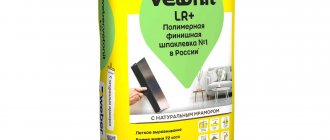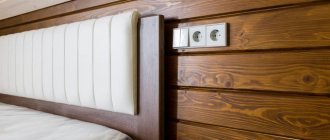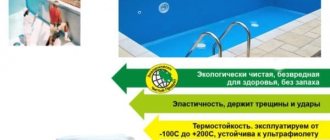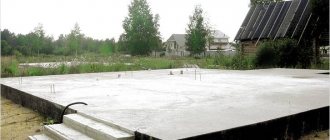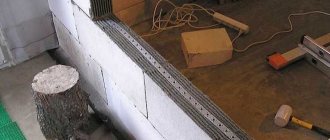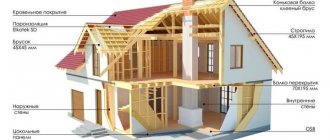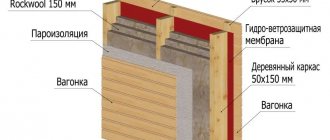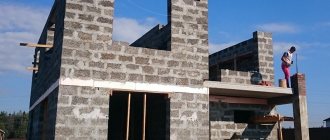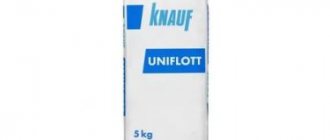Questions about bathroom waterproofing
Vitalian, in short, if I were you, I would focus on the waterproofing of the bathroom in general, and on plaster walls in particular. Now in detail. About the walls. The base for wall tiles should be made from TsPSki, and it doesn’t matter where: the walls in the bathroom or the apron in the kitchen. Such a foundation is stronger in itself, and most importantly, it is not afraid of water. When exposed to water, gypsum softens and swells. Any topcoat will fall off under such conditions. In turn, water can get under the tiles in two ways. The first is from the outside through the seams. For this to happen, even on joints with conventional cement-based grout, the tiles must be in constant contact with water. Moreover, experience the pressure of the water column, i.e. be the bottom of a swimming pool or at least the bottom of a shower stall with a poorly organized drain. Water falling on a vertical tiled surface and flowing freely to the bottom will only penetrate the seams in sufficient quantities if it flows 24/7. And this is only possible in a public shower. The second way is “from within”. A classic example is flooding by neighbors above. Water penetrates the body of the wall through its junction with the ceiling and subsequently spreads throughout the entire volume (depending on the type and material of the walls). If suddenly the walls under the tiles are already plastered with gypsum, then waterproofing in the first case (IMHO!!!) is not needed, since the tile itself and high-quality grout, even cement-based, not to mention epoxy, will be more than sufficient waterproofing. In the second case, any waterproofing will not save. The only, in my opinion, necessary measure for preparing a gypsum wall for tiles in a bathroom is to reduce the vapor permeability of the gypsum base. This is done by repeatedly priming the surface with a deep-penetrating primer (preferably latex or even better, use concentrates). By the way, this will give the gypsum a slight short-term moisture resistance. From personal experience I will say that many colleagues in the shop (and indeed many, almost all) plaster the walls in the bathrooms under the tiles with a rotband. I have had to renovate flood damaged bathrooms where the tiles were laid on a plaster base. And I have never made any repairs due to damage to the gypsum base by water penetrating through the seams as a result of normal operation of the bathroom. Summarizing about the walls, I will say that the most correct decision was to initially plaster the TsPskaya. If it suddenly turns out that the walls are plaster, then don’t bother with waterproofing and don’t waste time with money, but just lay the tiles. Regarding waterproofing the floor. Over the past 10 years, I have never encountered a customer who wanted to either lower the floor level in the bathroom or install a waterproof threshold in the doorway. The hit of our time is a single floor plane throughout the entire apartment. Now imagine how you diligently waterproofed the floor in the bathtub, and if there is any leakage, the water will not stay there for a second and will flow throughout the apartment on laminates and other carpets. And where in this situation is there any practical value in the labor and financial costs of this waterproofing? Well, or even if someone lowered the floor and created a threshold. What volume of water will be retained by this threshold until the water flows through it into the apartment? The flow rate of a water tap in an average high-rise building is 15-30 l/min. How much water will flow during your 8-hour absence on a working day if, for example, the flexible connection to the mixer bursts? By and large, water from the bathroom should drain through the holes in the ceilings where the sewer pipe runs all the way to the basement, minimizing damage to both you and your neighbors below. Only everyone strives to not only cover up the gap between the pipe and the slab, but also waterproof it.
Weber Vetonit weber.tec 822 / Weber Vetonit Weber.Tec 822 polymer mastic
Advantages
- Easy to use / Ready to use.
- Reliable. Water resistant to 3 meters water column.
- Fast. Tiling after 24 hours.
- Durable. Covers cracks, elasticity 270%.
- Comfortable. Two colors to control the application of layers.
Purpose
- For waterproofing floors and walls in damp and wet areas before laying tiles.
- For quick and dust-free waterproofing work in showers, toilets, bathrooms, and laundries.
Specifications
| Color | gray and pink |
| Consistency | semi-liquid |
| Density, kg/l | 1,6 |
| Extensibility, no less | 270% |
| Drying time for all layers at a temperature of +20°C, hour | 10-15 |
| Number of layers required | 2 |
| Permissibility of laying tiles (at a temperature of 20°C and a relative humidity of 50%), hour | no earlier than 24 hours after |
| carrying the last layer | |
| Layer thickness, mm | 0,8 |
| Minimum consumption, kg/sq.m | 1,2 |
| Application temperature | from +5° to +30°С |
| Operating temperature | from -35° to +70°С |
Instructions for use
Preparing the base
During waterproofing work and for two days after completion, the temperature of the base and air should not be lower than +5 °C and not higher than +30 °C. The substrate must be hard, dry, free of dust, oil, grease and loose particles. Gypsum-containing and absorbent substrates should first be treated with weber.prim multi. Base plates that are too smooth should be roughened. Porous and porous wall surfaces should be puttied with weber.vetonit VH.
Application
- Weber.tec 822 waterproofing mastic is ready for use. Do not add solvents or other reagents to it. It is easily applied with a roller or brush.
- To make it easier to control the quality of coverage of walls and floors, mastic is produced in 2 colors - gray and pink.
- Vertical and horizontal connections such as “wall-to-wall”, “wall-to-floor”, etc. should be insulated with a special weber.tec 828 DB 75 tape, which is glued using weber.tec 822 mastic.
- After this, the material is applied to the entire insulated surface. First, one layer of red is applied to the base, and after it dries, after 2-4 hours, a layer of gray is applied. The contrast between the colored layers allows untreated areas to be revealed.
- The total thickness of both layers of waterproofing is at least 0.8 mm. weber.tec 822 mastic covers the entire surface of walls and floors without seams.
- During work and for 24 hours after completion, the surface should be protected from moisture and precipitation, direct sunlight, strong wind and rain.
Precautionary measures
When working, you must use rubber gloves; avoid prolonged contact with skin and eyes; In case of contact with eyes, rinse with plenty of water; keep away from children.
Cleaning the instrument
Hands, tools and containers must be cleaned with water immediately after finishing work.
Disposal instructions
- Hardened material must be disposed of as construction waste. The material must not be discharged into the sewer.
- Dispose of the plastic bin as regular waste.
Transport characteristics
Plastic buckets of 8 and 24 kg. (Net weight). When sealed in factory containers and in dry rooms, the material can be stored for at least 12 months.
Polymer mastic for insulation Weber.Tec 822 (gray), 8 kg
Preparing the base
The substrate must be dry, sound, free of dirt, oil, grease and loose particles. For priming mineral or gypsum based materials, weber.prim multi should be used. It is recommended to prime highly absorbent and chalking substrates twice. Plastered surfaces and gypsum-based floors, gypsum boards, etc. should be roughened first. Irregularities in the base, cracks and seams must be sealed with a suitable material, for example, weber.vetonit S06.
Preparation of material
Before use, stir weber.tec 822 if necessary, without adding water or foreign substances.
Execution of work
It is recommended to carry out work at a temperature not lower than +10°C and not higher than +30°C; it is not recommended to carry out work in direct sunlight or in a draft. The material is applied to the prepared base using a brush and roller without skipping. Joints of vertical and horizontal (floor - wall) or vertical (wall - wall) surfaces should be additionally insulated with weber.tec 828 DB75 waterproofing tape, gluing it with weber.tec 822.
It is necessary to apply at least 2 layers: first, a pink layer is applied to the base, and after it dries (after 3 hours at +20°C and air humidity 50%), a gray layer is applied. It is recommended to use material of different colors (pink and gray) for better control of surface coverage. It is allowed to use material of the same color.
Attention
Weber.tec 822 is not suitable for waterproofing standing water tanks such as swimming pools, wells, fountains, etc. The slow drying of the material at low temperatures and high humidity should be taken into account. After application, it is recommended to protect the material from water and direct sunlight.
Subsequent tiling
Tiling can be started no less than 24 hours after applying the last layer of waterproofing (at +20°C and air humidity 50%). Tile adhesive is selected depending on the type and format of the tile used. Suitable adhesive mixtures: weber.vetonit granit fix, weber.vetonit profi plus, weber.vetonit stone fix, weber.vetonit ultra fix.
Precautionary measures
When working, you must use rubber gloves; avoid prolonged contact with skin and eyes; In case of contact with eyes, rinse with plenty of water; keep away from children.
Cleaning the instrument
Hands, tools and containers must be cleaned with water immediately after finishing work.
Disposal instructions
Hardened material must be disposed of as construction waste. The material must not be discharged into the sewer. Dispose of the plastic bin as regular waste.
polymer mastic for waterproofing under tiles in the bathroom
Purpose. ― Waterproofing in the bathroom under tiles and plasterboard panels. ― Waterproofing of any mineral substrates, including plasterboard and gypsum plaster.Restrictions on use. ― Not suitable for waterproofing swimming pools, water tanks (bases under constant exposure to water). For such cases, use a cement mixture for waterproofing weber tec 824.
| ■ packaging | ■ consumption |
Specifications | |
| Color | grey, pink |
| Density, kg/dm3 | 1,6 |
| Consistency | semi-liquid |
| Application temperature | from +5°С to 30°С |
| Consumption, kg/m2 | 1.2 |
| Number of layers required | 2 |
| Layer thickness | 0.5 |
| Performance characteristics | |
| Operating temperature | from +5°С to 70°С |
| Drying time (at 20°C), hour | 10-15 |
| Laying tiles (at 20°C, after applying the 2nd layer) in an hour | 24 |
| Description of polymer waterproofing under tiles WEBER tec 822 |
weber tec 822 mastic is a polymer mastic for elastic waterproofing of walls and floors under tiles in bathrooms, showers and other rooms with high humidity.
Substrates: concrete, cement screed, cement and gypsum plaster, putty, gypsum plaster, plasterboard, old tile covering.
Surfaces: walls, bathroom floors.
Instructions for use of polymer waterproofing mastic |
Preparing the base. Absorbent surfaces are treated with polymer bath primer weber prim 801 or weber prim multi. Corners between walls, between walls and floors, expansion joints on the screed, areas where different materials meet are sealed with waterproof weber tec 828 DB 75 tape. The tape is glued with tec 822. The pipe entry points are also insulated with cuffs made of tec 828 DB 75 tape.
Application of waterproofing Weber tec 822 polymer mastic is applied to the entire surface of the floor and walls in the bathroom in 2 layers. The total thickness of 2 layers should be more than 0.5mm, the time between applying layers is 2-4 hours (the first layer must dry before applying the second). To control the hiding power of the base waterproofing, it is recommended to use a pink composition for the first layer, and gray for the second.
Laying tiles Laying tiles on waterproofing can only be done 24 hours after applying the 2nd layer.
| Mastic storage and packaging |
Polymer mastic for waterproofing weber tec 822 is supplied in buckets of 8 and 24 kg. Can be stored at positive temperatures for 12 months in original packaging.
